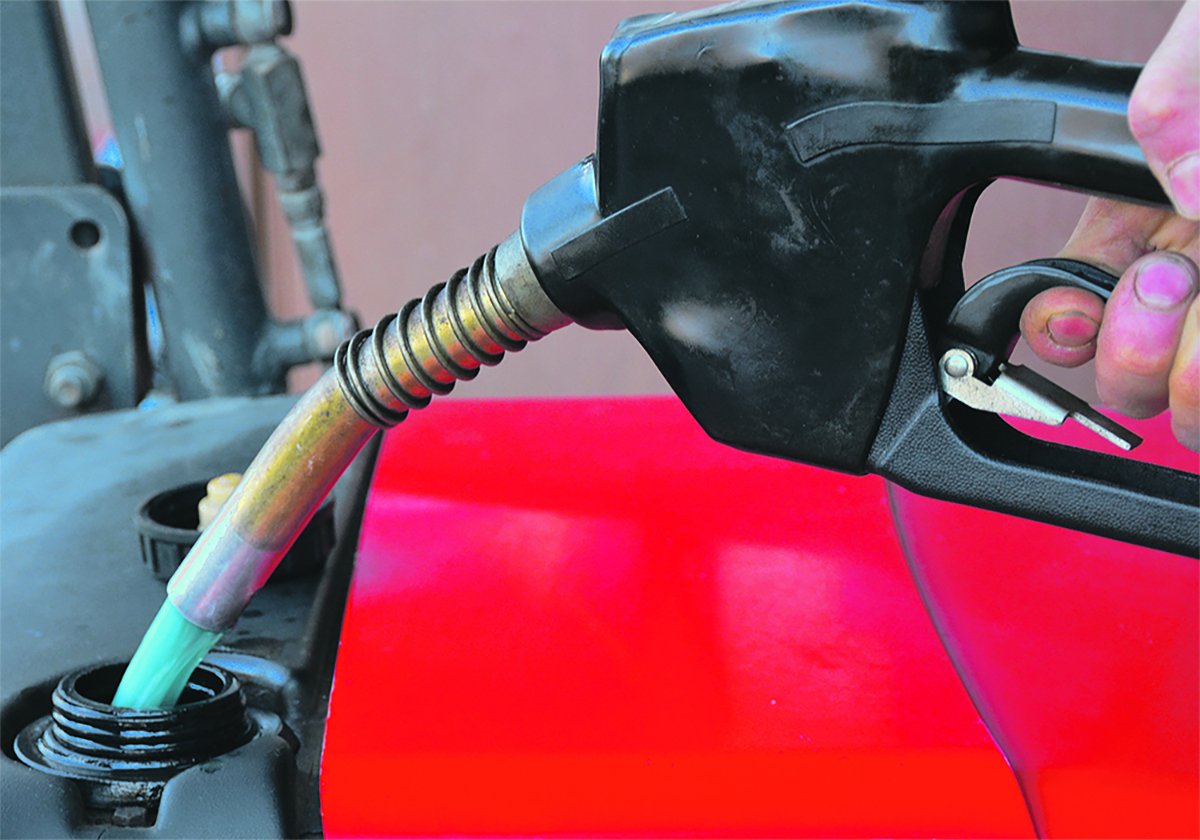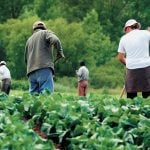A new air seeder option is providing prairie farmers with the best of both worlds.
The UltraPro Canola Meter, which is available on Seed Master drills, can handle conventional crops, but it’s also capable of uniform plant spacing within each seed row, which is required if corn and soybeans are to deliver their anticipated top yields and big paybacks.
It is based on a concept called seed singulation, which has been a standard function on corn planters for decades.
However, a dedicated corn planter capable of seed singulation is an investment most prairie farmers have been reluctant to make in a crop that still constitutes a small percentage of their acres.
Read Also

Alberta may eliminate marked fuel
Alberta may soon stop selling dyed gasoline and diesel.
That investment has been one of the obstacles standing in the way of corn and soybean expansion.
Seed Master president Norbert Beaujot said he has been working on a dual-function drill for some time, and it’s now available as an option on his company’s drills.
The UltraPro Canola Meter is a few quick changes away from being capable of delivering corn seed in a relatively uniform spacing down the row.
Beaujot stops short of calling it true seed singulation, but said it’s the next best thing.
“It’s not seed singulation in the strictest sense of the word because true singulation is done at the opener where the seed drops to the ground. And it’s perfect,” he said.
“But this is a giant step in that direction for air seeders. I think it’s as close to true seed singulation as you can get in an air delivery system.
“It’s close enough to true singulation that a producer can buy just one drill for all crops, including corn. It’s close enough that you don’t need a dedicated corn planter.”
Beaujot said seed singulation and uniform plant placement within the row is likely not possible in densely seeded cereal crops such as wheat, nor is it important when the seeds are only half an inch apart.
However, it becomes more important for canola and sunflowers, in which ideal plant spacing ranges from two to 14 inches.
Growers of those crops do not want to see two or three plants emerge from the same point and then spend the growing season battling each other for supremacy.
Uniform plant spacing becomes a greater challenge as more producers move toward wide row spacing.
Beaujot said wide row spacing is essential if producers want to grow big heavy crops, but there are special challenges.
Wider row spacing in crops such as wheat normally pushes more seeds into fewer rows in the field. However, Beaujot cautions against over seeding, especially with high-cost hybrids.
He urges growers to put down fewer seeds per acre, thus giving each plant more space for better growth. However, this makes it more important to have better metering systems and better plant spacing.
“It doesn’t make sense that we can achieve seed depth accuracy of one eighth of an inch but still have random seed distribution in the seed row,” Beaujot said.
“We think that seed metering is the next major frontier in air seeders. You don’t want an expensive seed and a high-value plant competing with its neighbours for sunlight, moisture and nutrients. We’re starting to see now that uniform seed spacing down the row is probably just as important for canola and soybeans and sunflower as it is for corn.”
The UltraPro system selects individual seeds at the meter rather than at the opener, which Beaujot said is vastly different than bulk metering.
“We have a very narrow section of the meter roller that picks up only one or two seeds at a time,” he said.
“In the cases where it picks two seeds, by the time the seeds get down to the end of a 50 foot hose, they are uniformly separated.”
The orifice feeding the roller chokes down tight enough that no more than two seeds can enter the roller at one time. In the canola mode, the roller picks up the seed at the bottom of the roller.
Switching to the corn mode means changing the roller and the direction of rotation. The seed is now picked up at the top of the roller.
The prototype machine Beaujot used on his own farm this spring was set up for 14 inch row spacing, and the target plant population at that spacing in his 30 acre cornfield penciled out to one corn plant every 14 inches, or a perfect 14-inch square if everything works perfectly.
And it almost did.
He said his overall plant population and seed count worked out to a perfect average of one plant every 14 inches, based on 35,000 plants per acre.
But was it true singulation?
“We gained a lot from the standard random seed distribution we used in the past, but no, it’s not perfect singulation,” Beaujot said.
“There are a few places where we see variances of 10 to 18 inches between plants. Plus it’s very rare to see two corn plants close together anywhere in the field. That in itself is a major accomplishment.”
He said the new system also accomplished one pass seeding with all fertilizer going down with the seed.
“We side banded 135 pounds of actual N (nitrogen) while seeding the corn. That’s 400 lb. per acre of actual product. That went down an inch and a half to the side of the seed and three quarters of an inch below.
“Right now (July 6), the crop looks great. There’s no sign that it suffered from that high level of fertilizer. These openers seem to work well for corn.”
The UltraPro Canola Meter lists for $50 per seed run.
For more information, contact Beaujot at 306-721-3001 or visit www.seedmaster.ca .
Researchers at the Western College of Veterinary Medicine in Saskatoon are e-mailing a questionnaire to western Canadian producers about neonatal disease.
A lot has changed in calf health in the last decade or so. Calving times are later on average, fewer people are available at calving, herds are spread out and veterinarians often prescribe longer acting products as a one-shot fix.
More recently, economic considerations caused by the BSE crisis have led to fewer calves being examined. Veterinarians tend not to attend calving unless there is a major problem.
Producers with large cow-calf herds must have a keener eye for sick calves because they are much harder to catch and treat in larger areas.
Vets see or hear about fewer scour outbreaks because of the effectiveness of scour vaccinations and better cow nutrition, which leads to better quality colostrum.
Colostrum deprivation is also less likely because of fewer calving issues due to lighter weight calves. Better quality colostrum substitutes have also led to far fewer immunocompromised calves.
Calves respond favourably to treatment in some scours outbreaks but not in others.
The WCVM study will focus on the answers to questions such as, “are the scours organisms different in some instances?”
Perhaps veterinarians need to look at less common diseases such as salmonella and cryptosporidiosis or further check clostridial organisms when scouring outbreaks occur.
Vaccinating cows more routinely for clostridial organisms with blackleg eight-or nine-way products may protect calves against some clostridial scours through the colostrum.
These developments are still in the research phase, and the questionnaire may help pinpoint the main areas that veterinary researchers need to focus on to improve the cow-calf industry.
The industry is also seeing fewer procedures done to calves at birth such as vitamin A, D and E and selenium shots or applying dehorning paste.
This is a result of better balanced nutrition and the breeding out of horns, but it can also be attributed to producer apathy, producers skimping on costs and labour and later calving seasons, in which calves cannot easily be caught.
Lower cattle prices and other challenges that followed BSE have sapped some producers’ energy to perform these extra tasks.
Perhaps rising prices will increase compliance of these procedures when they are necessary.
Standard money-saving procedures such as pregnancy and semen testing for culling are also not being done as routinely. Does this reflect tough economic times? I’d argue that
it makes more economic sense to do them when prices are low and feed is expensive.
One disease, such as a primary pneumonia, may often lead to neonatal diarrhea and vice versa. It is easy to concentrate on the most obvious clinical signs and miss the initial problem.
Ranchers may in some cases be treating the lesser of two problems, which is where the treatment choice is critical because many antibiotics are specific for pneumonia but may be ineffective against scours.
Other neonatal diseases such as navel infection lead to calves with poor health, often with joint infections. This has become less of an issue with later calving and herds that are spread out, but more work needs to be done.
When a cow has twins, one is often delivered backward. Navels can be ripped off short in those cases, and with the longer navel cord not acting as protection, infection wicks up inside.
Short navel cords can be an issue in caesarean sections. The calf is brought out backward and the cord rips off short if it is pulled out through the incision. Veterinarians can use a procedure when pulling the calf through the incision to ensure the cord rips off long.
Colostrum substitutes are now more readily available, although there can be a big difference in quality. This has heightened the awareness of supplying quality colostrum.
As well, colostrum uptake occurs earlier in smaller calves if vigour is high.
Timing of the calving season may yield different types of diseases. We never get heat stressed calves in February but it can be a problem in June.
A postmortem is easy for veterinarians to do and usually gives a definitive answer as to the cause of death. If still unsure, the veterinarian can send samples away for testing to eliminate guessing.
The comprehensive WCVM questionnaire does not take long to fill out and is anonymous. It will help individual producers and the entire livestock industry.
Head researcher Dr. Cheryl Waldner has also derived valuable information from a western Canadian beef study completed several years ago.
The questionnaire is also available on-line at www.usask.ca/beefresearch/Waldner.html by following the links.
Whether producers have had common neonatal diseases on their farms in the last year or if they have become fairly free of neonatal disease, it is excellent information for researchers to know.
Roy Lewis is a veterinarian practising in Westlock, Alta.
———















